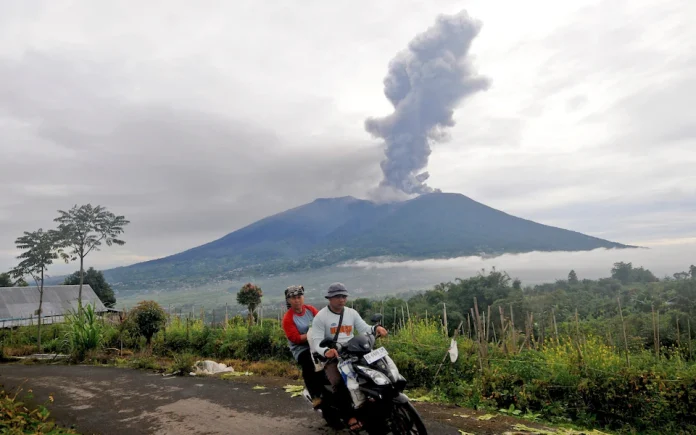Indonesian authorities have issued a tsunami alert and ordered more than 11,000 people to leave the area after the eruption of the Mount Ruang volcano.
The volcano on the northern side of Sulawesi island had at least five large eruptions in the past 24 hours, Indonesia’s Center for Volcanology and Geological Disaster Mitigation said.
Indonesia, an archipelago of 270 million people, has 120 active volcanoes and is prone to volcanic activity because it sits along the “Ring of Fire,” a horseshoe-shaped series of seismic fault lines around the Pacific Ocean.
Authorities urged tourists and others to stay at least six kilometers (3.7 miles) from the 725-meter (2,378 foot) Ruang volcano.
Officials worry that part of the volcano could collapse into the sea and cause a tsunami as in a 1871 eruption there.
Tagulandang island to the volcano’s northeast is again at risk, and its residents are among those being told to evacuate.
Indonesia’s National Disaster Mitigation Agency said residents will be relocated to Manado, the nearest city, on Sulawesi island, a journey of six hours by boat.
In 2018, the eruption of Indonesia’s Anak Krakatau volcano caused a tsunami along the coasts of Sumatra and Java after parts of the mountain fell into the ocean, killing 430 people.
According to a report, Indonesian volcano Mount Sinabung erupts after 400 years of quiet.
Tens of thousands of people packed emergency shelters Monday after a long-dormant volcano in western Indonesia spewed clouds of hot ash and smoke more than a mile into the air — an eruption that caught scientists off-guard.
The eruption of Mount Sinabung put the region on the highest alert level, and some domestic flights had to be diverted because of poor visibility.
Villagers living along Sinabung’s fertile slopes in North Sumatra province started heading down the 8,000-foot volcano after it began rumbling during the weekend.
An explosion Sunday was followed by a much more powerful blast Monday, and the number of people who evacuated hit 30,000, with hastily abandoned homes and crops blanketed in gray ash. The air was thick with the smell of sulfur.
Two people died, but Priyadi Kardono of the National Disaster Management Agency said it was too early to say if the volcano was to blame.
Sinabung last erupted in 1600, and officials acknowledged that they had not been monitoring the volcano because it had been dormant for so long.
“The nearest monitoring post to Sinabung is Mount Merapi — around 400 kilometers to the southeast — so we were totally in the dark. We didn’t know anything until it started rumbling,” said Imam Simulingga, a government vulcanologist.
He noted that there are 129 active volcanoes to watch in Indonesia, which is spread across 17,500 islands and is prone to eruptions and earthquakes because of its location within the so-called “Ring of Fire” — a series of fault lines stretching from the Western Hemisphere through Japan and Southeast Asia.
“We’ll be watching it closely from now on,” said Surono, another government vulcanologist, adding that because eruption patterns have not been observed, “we really have no idea what to expect.”
“We don’t know what set it off, how long it will continue or whether we should expect pyroclastic flows or more powerful eruptions,” added Surono, who like many Indonesians uses only one name.
Monitoring a volcano can include such techniques as looking for seismic activity that indicates disturbances from rising magma, sampling gases and looking for slight degrees of uplift in land, said Lee Siebert, director of the Global Volcanism Program at the Smithsonian Institution.
He said it’s no surprise that Sinabung would erupt after 400 years of being quiet. That’s not very long by geological standards, Siebert said, noting that a volcano that has erupted within the past 10,000 years can be considered active.
Like other volcanoes along the Sumatra fault line — the meeting point of the Eurasian and Pacific tectonic plates that have pushed against each other for millions of years — Sinabung has the potential to be very destructive.
Magma forming inside the conical tip can act as a plug, allowing pressure to build up until it reaches a bursting point.
“A volcano with a long repose period could deliver a more powerful eruption,” as was the case with Mount Pinatubo in the Philippines in 1991, which killed about 800 people, said Alain Bernard, a professor at the University of Brussels.
Sinabung could either go back to sleep or produce a series of blasts with increasing intensity, he said.
“A Pinatubo-size eruption is a rare event and unlikely to appear during the following days,” Bernard said.
“It takes normally weeks or months.”
The number of people evacuated to emergency shelters, mosques and churches reached more than 30,000 by Monday evening, said Erni Damanik with the Tanah Karo district information center.
Many wore respiratory masks to protect themselves against the soot and sulfur-choked air. Food, emergency tents and medicine were sent to the scene, officials said.
Although strong wind shifts or a powerful follow-up blast could affect air traffic in nearby Singapore and Malaysia, Transportation Ministry spokesman Bambang Ervan said only four domestic flights heading to the provincial capital of Medan were diverted so far.
The Eyjafjallajokul volcano in Iceland erupted April 14 and disrupted international flights for days. Pall Einarsson, geophysicist at the University of Iceland, said he saw no connection between that eruption and the one in Indonesia on Sunday.
Indonesia is home to some of the largest eruptions in recorded history.
The 1815 explosion of Mount Tambora buried the inhabitants of Sumbawa Island under searing ash, gas and rock, killing an estimated 88,000 people.
The 1883 eruption of Krakatoa could be heard 2,000 miles away and blackened skies region-wide for months. At least 36,000 people were killed in the blast and the tsunami that followed.
Source: itvNews














